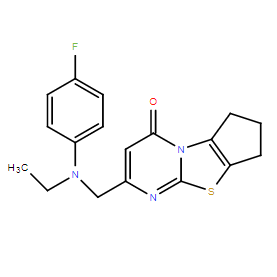| Cas No.: | 1698901-76-6 |
| Chemical Name: | 2-((ethyl(4-fluorophenyl)amino)methyl)-7,8-dihydro-4H,6H-cyclopenta[4,5]thiazolo[3,2-a]pyrimidin-4-one |
| Synonyms: | GNE-8324; GNE 8324; GNE8324 |
| SMILES: | O=C1C=C(CN(CC)C2=CC=C(F)C=C2)N=C3N1C(CCC4)=C4S3 |
| Formula: | C18H18FN3Os |
| M.Wt: | 343.11 |
| Purity: | >98% |
| Sotrage: | 2 years -20°C Powder, 2 weeks 4°C in DMSO, 6 months -80°C in DMSO |
| Description: | GNE-8324 is a potent and selective NMDA receptor PAM. |
| In Vitro: | Both GNE-6901 and GNE-8324 increase Glu potency, whereas neither PAM had significant effects on glycine (Gly) potency. Furthermore, both compounds slowed channel deactivation kinetics. However, GNE-8324 caused significantly slower NMDAR current deactivation following the termination of Glu application, compared to GNE-6901. Interestingly, when Gly was removed following the rapid Glu/Gly application in the constant presence of Glu, NMDAR currents rapidly deactivated in the presence of either GNE-6901 or GNE-8324, which is in sharp contrast to the slower NMDAR current deactivation in the presence of GNE-8324 when Gly was not removed. The authors argued that this demonstrated a specific interaction of PAMs with Glu but not Gly. However, these data also suggest that the slower NMDAR current deactivation in the presence of GNE-8324, but not GNE-6901, is highly dependent on ambient Gly concentration. GNE-8324 also markedly increased potency of Glu at GluN1/GluN2A NMDARs by about 10-fold while GNE-6901 had a much smaller effect on Glu potency. Finally GNE-8324 potency was strongly dependent on Glu concentration, whereas Glu concentration had only a modest effect on GNE-6901 potency. The deferential effects of GNE-6901 and GNE-8324 on GluN1/GluN2A NMDAR function could reflect subtle differences in modes of action of these closely related compounds, which might lead to distinct actions on NMDAR modulation in physiological settings. |

 To enhance service speed and avoid tariff delays, we've opened a US warehouse. All US orders ship directly from our US facility.
To enhance service speed and avoid tariff delays, we've opened a US warehouse. All US orders ship directly from our US facility.




















